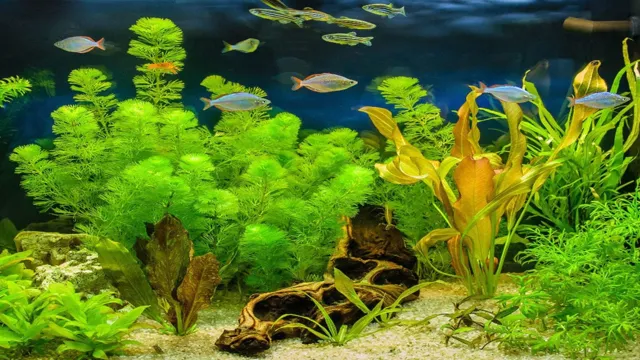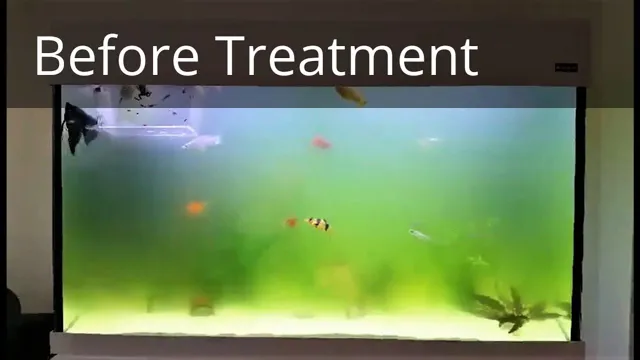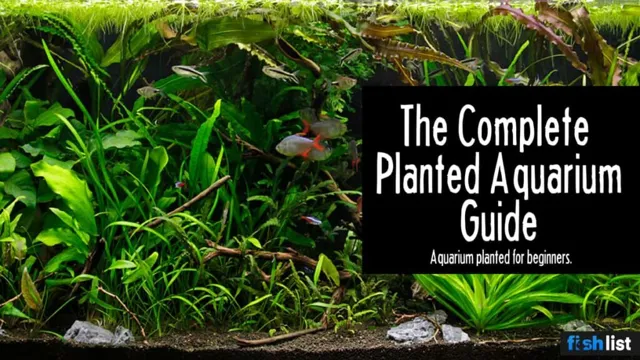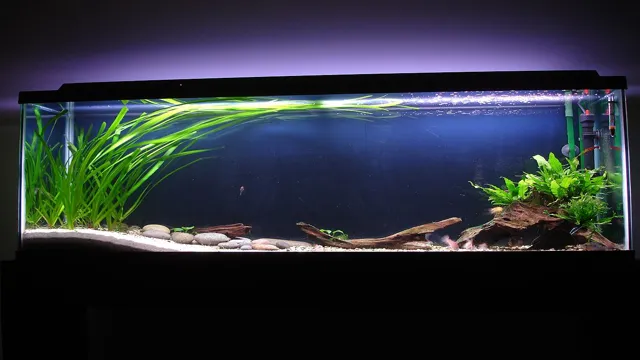As an aquarium owner, you want to ensure that your aquatic plants have the best environment for growth. Light is a crucial component of any planted aquarium, making it essential to select the right light. But, with so many different options available on the market, identifying which light is suitable for your planted aquarium can be challenging.
Thankfully, there are ways to determine what type of light you need for your aquarium. Understanding the basics of light and its impact on aquatic plants is the first step towards finding the perfect lighting for your aquarium. From there, you can identify the different types of lighting, including LED, fluorescent, and high-intensity lights, and figure out which one is best suited for your plants’ needs.
The wattage and color temperature of the light also play a significant role in your plant’s growth, making it crucial to select a light that aligns with their requirements. Having the right light in your planted aquarium will not only enhance the visual aesthetic of your tank but will also promote healthy plant growth. In this blog post, we will take an in-depth look at how to identify if a light is suitable for planted aquariums, providing you with the knowledge needed to create a thriving aquatic environment.
Check the Light Spectrum
When setting up a planted aquarium, it is crucial to check the light spectrum to ensure that the plants thrive. The easiest way to know if your light is suitable for plants is by checking the Kelvin rating. Most aquatic plants require a Kelvin rating between 5000K to 7000K.
This indicates that the light provides a full spectrum of light including red, blue, and green wavelengths, which are essential for photosynthesis. Another factor to consider is the intensity and duration of light. Most plants need at least 8-10 hours of light per day, while high light plants may require up to 12 hours.
A light timer can be a useful tool to ensure your plants get the right amount of light each day. Keep in mind that different types of plants have different light requirements, and it may take some experimentation to find the perfect setup for your aquarium. So, if you want to ensure that your plants thrive and your aquarium looks stunning, make sure to check the light spectrum before setting up your tank.
Look for wavelengths between 400-700nm
Have you ever wondered why plants need sunlight to grow? It’s all about the light spectrum. When it comes to growing plants indoors, it’s important to choose light bulbs with the right wavelengths. Plants mostly use light wavelengths between 400-700nm, which are known as PAR (Photosynthetically Active Radiation).
This range is perfect for photosynthesis, which is crucial for a plant’s growth. Blue light, which is on the lower end of this spectrum, promotes more vegetative growth and is great for seedlings. Red light, which is on the higher end of this spectrum, promotes blooming and fruiting.
By selecting the right spectrum of light, you can give your plants the best chance of reaching their full potential. So next time you’re looking for grow lights, remember to check the light spectrum and look for wavelengths between 400-700nm.
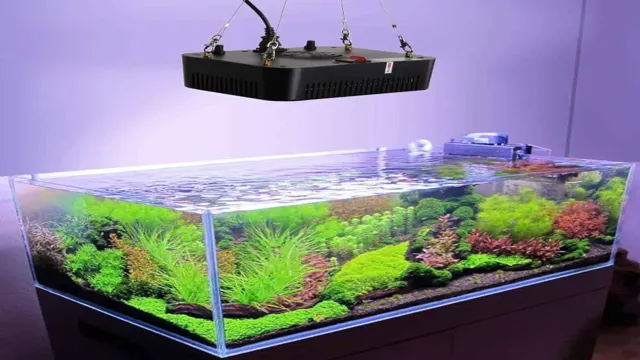
Blue and red light wavelengths are helpful for plant growth
When it comes to growing healthy plants, it’s essential to make sure that they’re receiving the right amount and type of light. In particular, blue and red light wavelengths are crucial for plant growth. Plants absorb blue light wavelengths, which help stimulate their growth and development.
Red light, on the other hand, promotes the flowering and fruiting stages of plants by triggering hormones that make them bloom. To make sure your plants get the right amount of blue and red light, check the light spectrum of your grow lights. You want to ensure that your grow lights emit light in the range of 400-500nm (blue) and 600-700nm (red) to optimize your plant growth.
Don’t forget to monitor the amount of light your plants receive as well, as too much or too little light can be detrimental to their growth.
Check the Light Intensity
If you’re wondering whether your aquarium light is suitable for your planted tank, one of the most important things to consider is light intensity. Plants require a certain level of light to grow and thrive, and if the intensity isn’t adequate, they may not get the energy they need to photosynthesize and stay healthy. One way to tell whether your light is designed for a planted aquarium is to check the intensity in terms of watts per gallon.
Generally, a good range for planted aquariums is around 2-5 watts per gallon, but this can vary depending on factors like the type of plants you have and the size of your tank. You can also look for lights that are specifically labeled as suitable for planted tanks, as these will often have a higher intensity and may include features like adjustable spectrum settings to promote optimal growth. By paying attention to light intensity, you can help ensure that your plants get the light they need to stay healthy and vibrant. (See Also: How to Make Aquarium Water Blue: Step-by-step Guide and Tips)
Measure the intensity of the light using PAR meter
When it comes to growing plants indoors, checking the intensity of light is a crucial step in ensuring their healthy development. A PAR meter can help you measure the photosynthetically active radiation (PAR) or intensity of the light that your plants receive. It is a handheld device that measures light in micromoles per second per square meter (μmol/m²/s).
By using a PAR meter, you can make sure that your plants are getting the light they need without under or overexposing them. This will help prevent issues like stunted growth and burned leaves. Furthermore, monitoring the light intensity can also help you make informed decisions about the optimal placement of your plants.
For example, you can adjust the height or distance of your grow lights to ensure that all areas of the plant are receiving equal amounts of light. So, if you want your indoor plants to flourish, investing in a PAR meter is a smart choice that will help you achieve the ideal growing conditions.
Plants require around 20-50 PAR to grow properly
When it comes to growing plants properly, light intensity is a crucial aspect to consider. The amount of light that a plant requires is measured in PAR (Photosynthetically Active Radiation). Typically, plants require around 20-50 PAR to grow properly.
However, this can vary depending on the type of plant and the stage of the growth cycle. To check the light intensity, you can use a simple handheld PAR meter that measures the amount of light that is reaching your plant. This will help you to ensure that your plant is getting the optimal amount of light.
If the light intensity is too low, the plant may become stunted or weakened, while if it is too high, the plant may become burnt or damaged. It’s essential to strike the right balance to ensure healthy growth. Remember that plants are just like us, they need the right amount of light to thrive, not too little and not too much.
By checking the light intensity and adjusting it accordingly, you’ll be well on your way to growing healthy, thriving plants.
Check the Light Duration
If you’re wondering how to know if your light is suitable for a planted aquarium, checking the light duration is a good place to start. Most plants need at least 8 hours of light daily to grow properly. However, different plants have different light intensity requirements, making it essential to understand the lighting conditions required by the specific plants in your aquarium.
It’s important to consider the wattage and intensity of your light to know if it can provide enough light for your plants to grow healthily. Additionally, remember to check the light spectrum; plants require red and blue lights to photosynthesize and grow correctly. Before purchasing any light for your planted aquarium, ensure that it meets all the needs of your plants.
By providing the correct lighting conditions, you’re setting up your plants for success and ensuring that your aquarium remains healthy and thriving.
Ensure the light is on for 12-14 hours per day
If you want to keep your indoor plants thriving and looking their best, it’s essential to ensure they get enough light. But did you know that the duration of light exposure is just as important as its intensity? For optimal growth and development, your plants need at least 12-14 hours of light per day. To check if your plants are getting enough light, you can use a timer to monitor the number of hours they are exposed to light.
Remember, not all plants require the same amount of light. So, it’s best to research the specific needs of your plant species to create a suitable lighting schedule. Providing the right amount of light will not only ensure that your plants remain healthy and vibrant but will also promote their growth and enhance their overall appearance.
So make sure you check the light duration to keep your indoor plants shining bright with health and beauty. (See Also: How to Put a Squid in Your Aquarium Minecraft: A Step-by-Step Guide)
This mimics the natural duration of sunlight in a day
When it comes to indoor plants, setting them up for success begins with understanding their basic needs. This includes factors like water, nutrients, and light. In particular, how long and how often your plants receive light can make a huge difference in their growth and overall health.
Many experts recommend mimicking the natural duration of sunlight in a day, which typically lasts around 12 hours. This helps ensure that your plants receive the optimal amount of light without being overexposed. Of course, the specific amount of light your plants need can vary depending on the species.
Some may require more or less light, especially if they’re native to different regions with varying sunlight patterns. It’s important to check the recommended light duration for each of your plants and adjust accordingly. By ensuring that your plants receive the right amount of light for their needs, you can help them thrive and create a beautiful and lush indoor garden.
Conduct a Plant Growth Test
If you have doubts about whether your light is suitable for a planted aquarium, a plant growth test can tell you a lot. The first step is to select a handful of different plant species and place them in different areas of the tank. This lets you see how each plant reacts to different light conditions.
Next, keep an eye on the plants over the course of several weeks. If the plants are thriving and growing well, with healthy green leaves and stems, then your light is likely suitable for a planted aquarium. If the plants are struggling and turning yellow or brown, it might be a sign that they are not getting enough light.
Alternatively, if the plants are growing too quickly and developing long, spindly stems, it could be a sign that they are getting too much light. By conducting a plant growth test, you can get a good idea of whether your light is meeting the needs of your aquarium plants and adjust accordingly.
Observe plant growth after 2-4 weeks under the light
If you’re curious about how your indoor plants will fare under a grow light, conducting a plant growth test may be a helpful experiment. To begin, select a few of your healthy plants and place them under the grow light for 2-4 weeks. Make sure to note the current height and overall appearance of the plants before starting the experiment.
After 2-4 weeks, observe the plants closely to see any changes in growth, leaf color, or overall health. It’s common for plants to grow taller and develop more leaves when exposed to artificial light for extended periods, but you may also notice some changes in the color of the leaves or the thickness of the stems. By conducting this experiment, you’ll be able to better understand how your plants respond to the light and determine if a grow light is a good investment for your indoor gardening needs.
So go ahead and give it a try, who knows maybe your plants will surprise you with how much they grow!
Look for healthy, vibrant growth in your plants
If you’re a plant owner, you know that healthy and vibrant growth is the key to a flourishing garden. Conducting a plant growth test can help you ensure that your plants are thriving and reaching their full potential. This test involves measuring the height, width, and number of leaves on your plants over a period of time.
By collecting this data, you’ll be able to see if your plants are growing at a steady rate or if they’re experiencing stunted growth. If the latter is the case, you can take action to address the issue, such as adjusting watering or fertilizing schedules, or moving the plant to a more suitable location. Remember, just like how our bodies need regular check-ups, our plants need regular evaluations too.
Keep them strong and healthy by conducting a growth test every now and then. (See Also: How Thick Does Acrylic Need to be for an Aquarium: A Comprehensive Guide.)
Conclusion
If you’re still wondering if your light is suitable for a planted aquarium, there are a few things you can do. First, check the wavelength of your light. Plants need a spectrum between 400-700nm to photosynthesize effectively.
Second, check the intensity of your light. You want to aim for around 30-50 PAR for low-light plants, and 50-80 PAR for medium-light plants. Finally, observe your plants.
If they’re thriving and growing well, then your light is likely doing its job. But if they’re struggling or not growing at all, it may be time to invest in a better light source. So, remember to pay attention to the details and your plants will thank you for it!”
FAQs
What is the difference between a regular aquarium light and a light for planted aquariums?
A light for planted aquariums generally has a higher intensity and a spectrum that promotes plant growth.
Can I use a regular fluorescent light for my planted aquarium?
It is not recommended as regular fluorescent lights do not have the necessary spectrum for plant growth.
How many hours per day should I leave the light on in my planted aquarium?
Typically, 8-10 hours per day is ideal for a planted aquarium, but this can vary based on the types of plants and fish in the tank.
Do all plants require the same type of light in a planted aquarium?
No, different plants have different light requirements. It’s important to research the specific needs of the plants in your aquarium.
How can I tell if my light is strong enough for my planted aquarium?
You can use a PAR meter to measure the intensity of your light. Ideal PAR values depend on the type of plants in your aquarium.
Can too much light harm the plants in my planted aquarium?
Yes, excessive light can lead to algae growth and harm the plants. It’s important to moderate the amount of light your aquarium receives.
How often should I replace my planted aquarium light bulbs?
Light bulbs should be replaced every 6-12 months to ensure they are producing the correct spectrum for plant growth.




